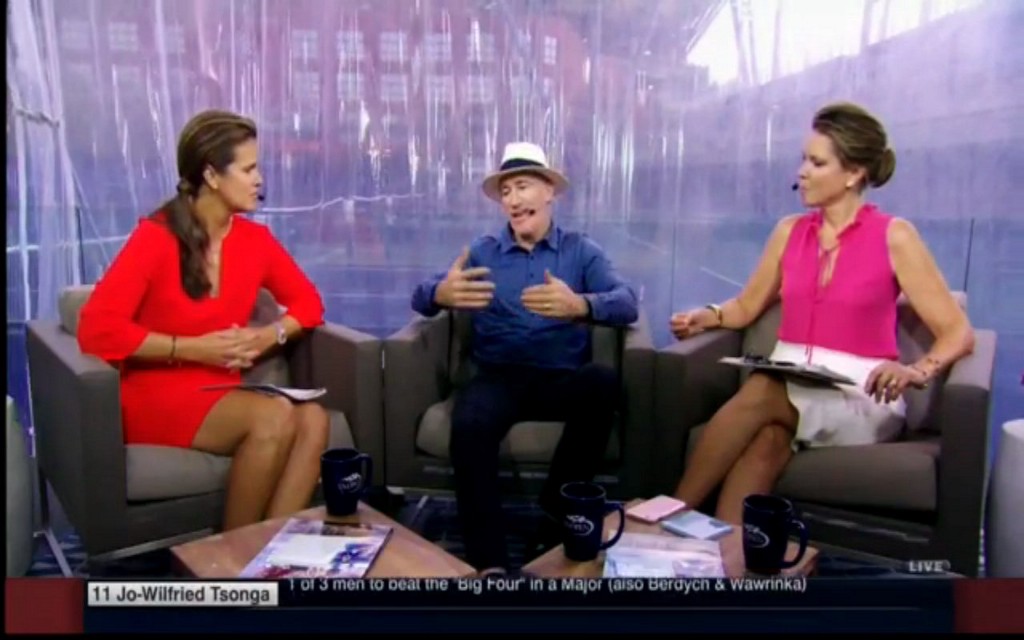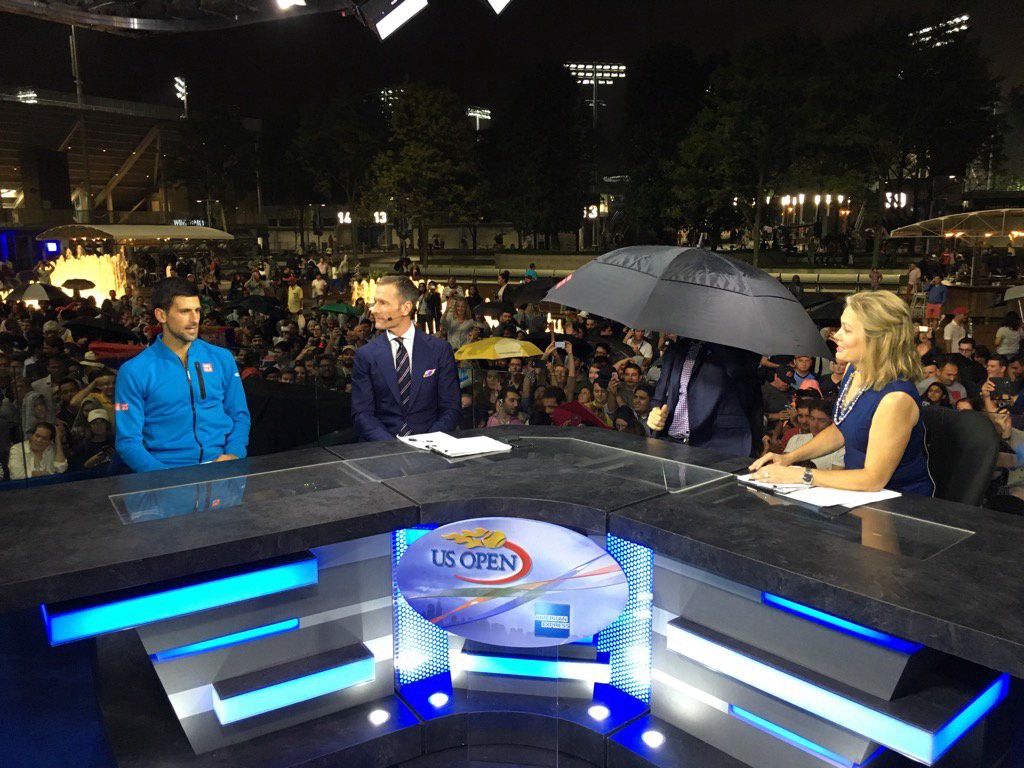"Bad" Gilbert Is The Fedora Of Tennis
The sport needs more female commentators, and fewer bad hats and nicknames

Tennis matches can be very long, and for the uninitiated, rather confusing. Distinguishing the groundstrokes is difficult. The scoring belies mathematical logic. Most of the time, even the players appear baffled by the challenge system. In this sporting world, one wants a well-informed guide, or at least pleasant company for matches that can extend beyond four hours. Instead, there’s Brad Gilbert.
Throughout his long career, Gilbert has worn many hats (sorry): ESPN commentator, tennis coach, author, former world no. 4, a signature Raiders cap, a black Metallica bucket hat in the stands of all-white Wimbledon, and for the most recent US Open, an abundant collection of fedoras.
Tennis has always provided a welcoming home for the lover of funny hats. The visor of yore persists alongside headbands — neon, elastic, and those tied and retied by hand. The latter acts as salve for the neurotic tennis player performing the server’s sign of the cross: headband, necklace, hair tuck, towel. So it is perhaps unfair to harp on the minutiae of Gilbert’s headgear in a sport preoccupied with such strange fashion.
But Gilbert’s hats are not stylish; they’re a stunt. One designed to increase the visibility of Brad Gilbert. One suspects the Metallica bucket hat was worn less as the good luck charm for his player (as it was admitted to be), and more as a cloying attempt at quirkiness, intended to entice a frequent zoom from the Skycam. In a post-match interview, he once asked Roger Federer not about his match, but about Gilbert’s own attempt to sport a headband. “Not a good look,” said Federer:

The rules of hats are not sacred, but they do exist. And while the evolution of fashion necessitates the occasional disobedience, most of us would be well advised to play along. This rulebook is hardly stringent. Take your hat off indoors. Do not wear the same hat every day. The fedora is a dress hat, and while it can be paired with causal wear, Miss Manners advises caution. Gilbert breaks all of these rules. Indoors, outdoors, shirts collared or not — in the Gilbert wardrobe, fedoras pair with everything. (Even athletic wear.) The manic insistency of this uniform is deeply off-putting. As Dayna Tortorici reminded us, “Freddy Kruger, too, wore a fedora.”

One friend drew a comparison to the tailored zaniness of Craig Sager’s suits, noting that, even if Sager weren’t broadcasting from a basketball stadium, his wardrobe would remain largely unchanged, because he genuinely loves those suits. On the contrary, it’s harder to imagine Brad Gilbert sporting a Metallica bucket hat when there aren’t any cameras around.
Gilbert’s hats suggest a logic where anything done to excess increases visibility, a tendency toward overindulgence that also explains the nicknames he generates with stunning alacrity. Nicknames are not rare in sports, but they are typically reserved for stars — Big Papi, Flo Jo, The Final Five, Black Mamba — and usually, they are not generated all by one person. But Gilbert’s love of verbal associations is boundless. Take some familiars from this US Open. In Gilbert’s perplexing lexicon, the calm Simona Halep is “Halepeño.” Mild-mannered Stan Wawrinka, who won his third grand slam this month by waiting politely through Djokovic’s (the “Djoker”) questionable medical timeouts, is a “Stanimal.” The winner of this year’s US Open, the fully-grown adult woman Angelique Kerber, is the “Kerber Baby.” Andy Murray, whose squawking outbursts can appear vaguely avian, is surely not haggard enough to warrant “Muzzard” as a sobriquet.
Gilbert called Rafael Nadal “Ralph” until his fellow ESPN announcer, the always-elegant Chris Fowler, made him stop. When he suggested “Rotisserie Pouille” for Lucas Pouille, the Frenchman who ousted “Ralph” in the fourth round of the Open, Ivo Karlovic, the big-serving Croatian, responded over Twitter:
Rotisserie Pouille doesn’t make any sense cuz pronunciation is totally different then poullet (chicken). https://t.co/7Iuj2HtWP6
What do u think of change for Rotisserie Pouille to My name is Luca
To be clear, when “Rotisserie Pouille” received negative reactions, Gilbert’s response was to suggest an alternative: “My Name is Luca,” the title of a song about child abuse.
The problem with Gilbert’s nicknames, though, isn’t that they aren’t accurate or that no one else uses them, but that they aren’t funny. They’re one-sided attempts at inside jokes, designed to draw attention to the singular humor of Brad Gilbert.

To be fair, Gilbert does deserve some credit, just for different things. He coached grand slam winners Andre Agassi, Andy Roddick, and Andy Murray. He briefly coached Sam Querrey, but whether Sam didn’t rise in the ranks quickly enough or the sibilant consonants of his first name proved too difficult, their relationship fizzled.
The player-turned-broadcaster is familiar from many sports, as is the player turned coach. But tennis is the only sport I know of where individuals can hold both positions at once. Despite the glaring conflicts of interest, most navigate their dual role successfully. Darren Cahill (Simona Halep’s coach) and Patrick Mouratoglou (Serena Williams’ coach) are agile in their transitions, never serving as announcers for their own players’ matches and when asked to comment, appearing believable in their neutrality. After taking on Halep, Cahill went so far as to stop calling women’s matches altogether. Earlier this year, John McEnroe drew criticism for appearing in the booth during a match between Milos Raonic (whom he was consulting) and Federer, but even McEnroe, the most famous rude person in sports, acted with decorum when the pair split. Serving as both commentator and coach “ended up becoming an issue,” he said, adding, “I’d love to see all the guys play their best because I think it’s better for tennis.”
When Roddick and Murray each dropped Gilbert rather abruptly, he demonstrated none of this grace. On ESPN, shortly after his break with Roddick, he compared his former player’s match against Federer to a football game between Oklahoma and USC. The implication being that Federer (USC) humiliated Roddick (Oklahoma). Roddick responded, “There’s no question it’s a diss, but I’m not going to play that game.” As rehearsed with Roddick, so repeated with Murray. When asked about his breakup with the Brit, Gilbert sounds like a jilted lover praising what his ex has learned since the split: “We still speak. He is now doing a lot of things I was asking him to do.” First time farce. Second time, also farce.
Gilbert is best known as the coach for these players, because he talks about having coached them all the time. As a commentator, Gilbert draws frequent comparisons to Agassi’s return of service and Roddick’s serve. He speaks knowingly of the ins and outs of Murray’s game, a player he coached for only one year, nearly a decade ago. Grand slams bring together the top 256 players in tennis (give or take some wildcards), a group so diverse in talent that commentators should have plenty to talk about for two weeks of matches. But to hear Gilbert’s outsized emphasis on players he’s coached or consulted, you’d think the field comprised only his handful of players.
In the end, Gilbert’s antics recall a bit too strongly another place of fashion, nicknames, and resentment: the country club. To its credit, tennis has thoughtfully distanced itself from the monogrammed playground of its past, but Gilbert’s showy hats, epithets, and all-occasion fist bumps threaten to turn tennis back into the clubby world of insiders that tennis has worked hard to escape.
A less cranky person might ask, is the situation truly that dire? It’s only color commentary Gilbert’s providing anyway, and he is entertaining. (One twitter account parodies his grammatical errors and deep love of Bud Ice.) Call me a nicknameless grump, but Bad Gilbert bespeaks a larger issue for tennis commentary. After all, the country club is also deeply exclusionary to women.
Tennis’s attention to gender and wage equality has always been more progressive than most sports. In 1973, Billie Jean King founded the Women’s Tennis Association and weeks later, defeated Bobby Riggs in a “Battle of the Sexes” match. Later that year, the US Open became the first grand slam to offer equal prize money. It took thirty-four more years, but now all four slams provide equal pay to female and male players, and when Serena Williams is involved, women’s finals tend to sell out before men’s. But women still get less time on the court and in the booth. Women play best of three set matches, which means less time on television for the players and for the commentators, who are also (mostly) women.
In the early rounds of a grand slam, a pair of female commentators typically calls the women’s matches, but as the finals near — and the number of viewers increase — the announcing teams turn coed. In the most recent US Open, both female semi-finals were called by one man and one woman. The job of announcing the men’s semi-finals? Two men. For the finals, the depressing trend continued. One man and one woman called the women’s final while the men’s final was called by four men — three in the booth, and Gilbert in the stands.
In Sandy Harwitt’s book, The Greatest Jewish Tennis Players of All-Time, the chapter on Brad Gilbert is titled “The Chatterbox with Something Important to Say.” And his New York Times Magazine profile — “Brad Gilbert Talks a Great Game” — leads with the line, “Brad Gilbert won’t shut up.” Brad Gilbert certainly has things to say, but so do the other commentators.
During the recent US Open, female commentator Chris Evert had to interrupt Gilbert as well as John and Patrick McEnroe’s discussion of men’s matches to talk about the women who were currently playing on the court at that moment. “If the brothers McEnroe are finished” she cut in, her laughter forced and recognizable from any clubhouse.
It would be one thing if there were a dearth of talented, qualified female commentators. But Chris Evert has won eighteen grand slam singles titles. That’s eleven more than John McEnroe and eighteen more than Patrick McEnroe or Brad Gilbert. Pam Shriver, another ESPN commentator, holds twenty-one grand slam doubles titles. The McEnroe brothers combined have ten. Mary Joe Fernandez has two Olympic Gold medals.
Titles alone don’t create a good commentator, but consistency and exposure do. Chris Evert, Pam Shriver, and Mary Joe Fernandez are already strong announcers, but they only make up one third of ESPN’s analyst team. And it would be nice if an innocuous search for “female sports commentators” didn’t serve up links about the hottest women in sports journalism. These are institutional failures and not the fault of Gilbert alone, but defending his behavior as harmless color commentary renders the silencing of female commentators necessary for the sake of entertainment. Insisting that he quiet down, we all become killjoys, which is not quite a nickname, but one I’d happily take anyway.
Kelley Deane McKinney works at Cabinet Magazine and is currently taking tennis lessons.
